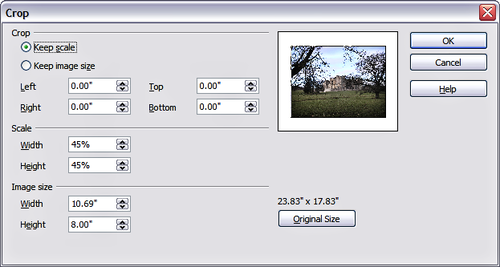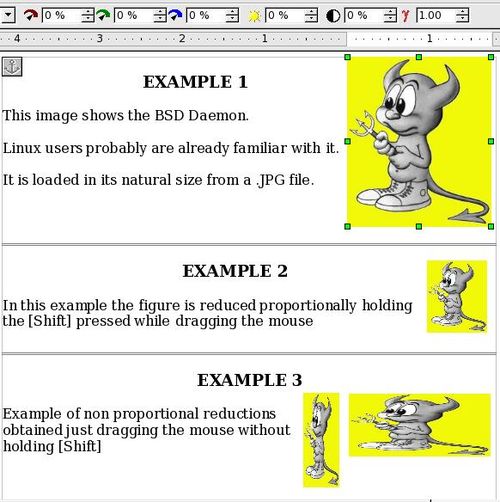Cropping, resizing, rotating, and other settings
- Adding images to a document
- Modifying an image
- Cropping, resizing, rotating, and other settings
- Using Writer's drawing tools
- Positioning graphics within the text
- Arranging, anchoring, and aligning
- Wrapping text around graphics
- Examples of wrapping
- Adding captions to graphics
- Adding an image to the Gallery
- Graphic file types supported
Cropping images
When you are only interested in a section of the image for the purpose of your document, you may wish to crop (cut off) parts of it. The user interface offered in Writer for cropping an image is not very friendly, so it may be a better choice to use a graphics package.
To start cropping the image, right-click on it and select Picture from the pop-up menu. In the Picture dialog box, select the Crop page.
In the Crop page, you can control the following parameters:
Keep Scale/Keep Image Size
When Keep scale is selected (default), cropping the image does not change the scale of the picture.
When Keep image size is selected, cropping produces enlargement (for positive cropping values), shrinking (for negative cropping values), or distortion of the image so that the image size remains constant.
Left, Right, Top, and Bottom
The image is cropped by the amount entered in these boxes. For example, a value of 3cm in the Left box cuts 3 cm from the left side of the picture.
- When Keep scale is selected, the size of the image also changes, so in this example the width will be reduced by 3 cm.
- When Keep image size is selected, the remaining part of the image is enlarged (when you enter positive values for cropping) or shrunk (when you enter negative values for cropping) so that the width and height of the image remains unchanged.
Width and Height
The Width and Height fields under either Scale or Image size change as you enter values in the Left, Right, Top, and Bottom fields. Use the thumbnail next to these fields to determine the correct amount by which to crop.
Resizing an image
The inserted image might not fit perfectly into the document if it is too big or too small. In these cases you can use Writer to resize the image.
- Click the picture, if necessary, to show the green resizing handles.
- Position the pointer over one of the green resizing handles. The pointer changes shape giving a graphical representation of the direction of the resizing.
- Click and drag to resize the picture.
- Release the mouse button when satisfied with the new size.
The corner handles resize both the width and the height of the graphic object simultaneously, while the other four handles only resize one dimension at a time.
Be aware that re-sizing a bit-mapped (raster) image will adversely affect the resolution, causing some degree of blurring. It is better to externally size your picture correctly before insertion into your presentation, if possible.
The figure below shows three examples of an image inserted into a document and resized.
For more accurate resizing, use either the Crop page of the Picture dialog box or, for images, the Type page of the Picture dialog box. On the Crop page you can either adjust the following settings or use the settings in the Crop section as described here.
- Scale Width and Height: specify in percentages the scaling of the picture. The size of the image changes accordingly. For a scaled resizing, both values should be identical.
- Image size: specify the size of the image in your preferred unit of measurement. The image enlarges or shrinks accordingly.
- Original size button: when clicked, restores the image to its original size.
In the Type page of the Picture dialog box, select the Relative option to toggle between percentage and actual dimension. For a scaled resizing, select the Keep ratio option. As for the Crop page, clicking on the Original Size button restores the original image size.
Rotating a picture
Writer does not provide a tool for rotating a picture; however, there is a very simple workaround:
- Open a new Draw or Impress document.
- Insert the image you want to rotate. You can use any of the mechanisms described in Adding images to a document, although there are some slight variations in the position of the menu entries and icons.
- Select the image, then in the drawing toolbar (shown by default at the bottom of the window in Impress and Draw), select the Rotate icon
 .
. - Rotate the image as desired. Use the red handles at the corners of the picture and move the mouse in the direction you wish to rotate. By default the picture rotates around its center (indicated by a black crosshair), but you can change the pivot point by moving the black crosshair to the desired rotation center. Template:Documentation/Tip
- Select the rotated picture by pressing Ctrl+A, then copy the image to the clipboard with Ctrl+C.
- Finish by going back to the location of the Writer document where the image is to be inserted and pressing Ctrl+V.
Other settings
The Picture dialog box consists of eight pages. The Crop page was described here, while the use of the Type and the Wrap pages is explained in Positioning graphics within the text. The other pages serve the following purposes:
- Options: use this page to give the picture a descriptive name (as you want it to appear in the Navigator), display alternative text when the mouse hovers over the picture, and protect some of the picture settings from accidental changes. You can also prevent the picture from being printed by deselecting the corresponding option.
- Borders: use this page to create borders around the picture. The Borders dialog box is the same as the one used for defining table or paragraph borders. You can also add a shadow to the image if so desired.
- Background: use this page to change the background color of the picture. This setting produces the desired results only for images with a transparent color.
- Hyperlink: use this page to associate a hyperlink to the picture. you can also create an image map so that only certain areas of the picture respond to a mouse click by opening the associated URI (Uniform Resource Identifier) in the default browser. More information on image maps can be found in the Impress Guide.
- Picture: use this page to flip the picture as well as to display the original location of the file in case the image is linked rather than embedded.
- Macro: allows you to associate a macro to the picture. You can choose among the predefined macros or write your own.
Deleting a picture
To delete a picture:
- Click on the picture, if necessary, to show the green resizing handles.
- Press Delete.
| Content on this page is licensed under the Creative Common Attribution 3.0 license (CC-BY). |

